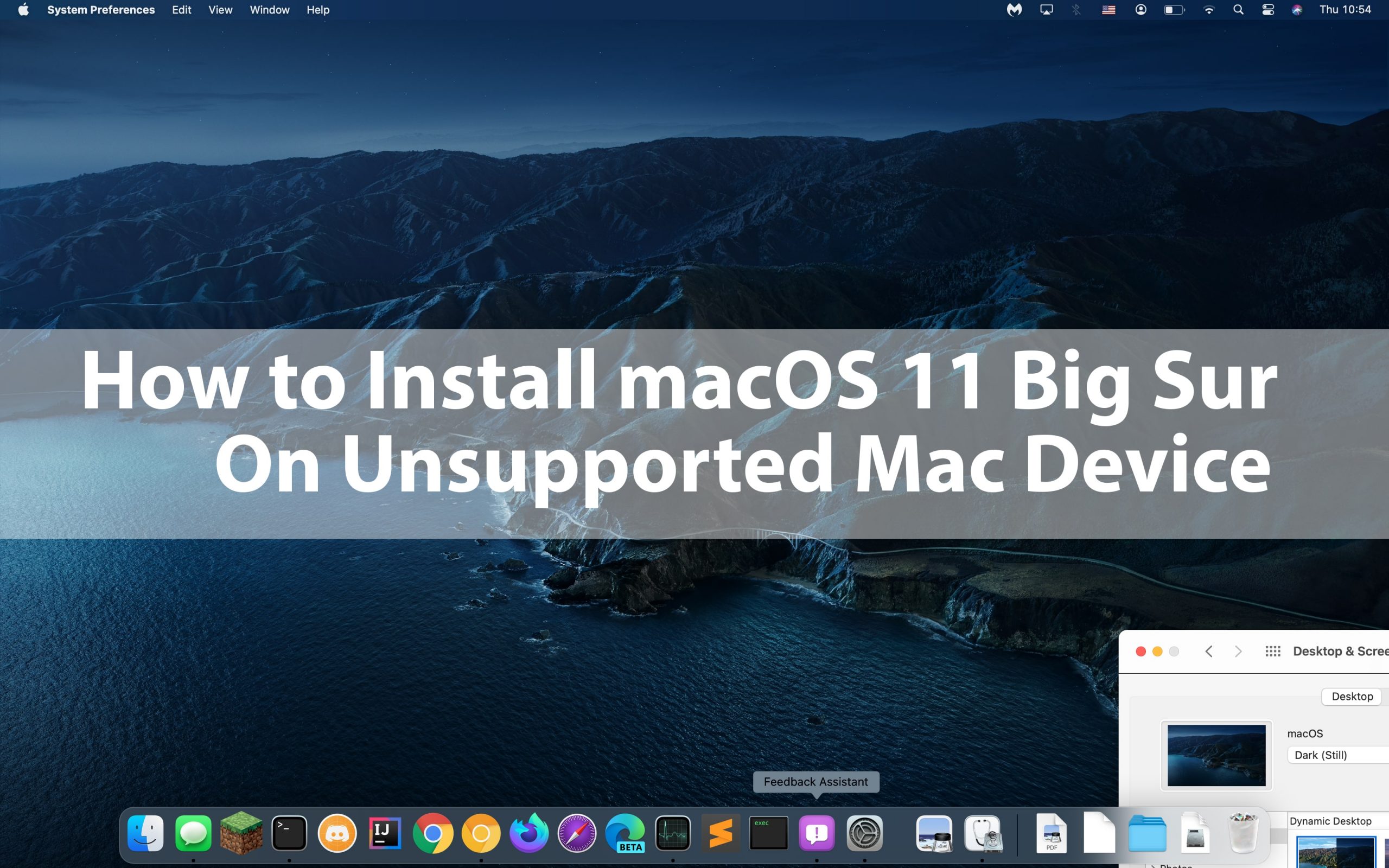The era of Mac OS X is over. Kind of.
Macos Catalina For Unsupported Macs Operating System
Nov 08, 2019 The video below demonstrates a tutorial walking through the process of using the DosDude Catalina patcher tool to install the macOS 10.15 system software on an unsupported Mac. If you’re going to attempt to install MacOS Catalina on an unsupported Mac, do so at your own risk, and let us know how it goes in the comments below.
Macos Mojave On Unsupported Mac This advisory describes the changes and steps administrators can take to deploy Mac Connector 1.14. The Mojave 10.14.1 update does NOT install properly on unsupported machines, and could result in an unbootable OS. In this video, I go over the process of installing macOS High Sierra on an unsupported Mac. This process involves the use of 'macOS High Sierra Patcher', whi. Jun 16, 2021 Make your old Mac support macOS Catalina. Older Mac owners don’t have to worry. It’s not the end of the world. There’s a patch that lets you install Catalina to Macs that are not officially supported. The patch is known as DosDude Catalina Patcher. DosDude Catalina Patcher is a third-party tool, meaning Apple does not develop the tool.
Macs compatible with macOS Big Sur (macOS 11): 2015 and later MacBook; 2013 and later MacBook Air; Late 2013 and later MacBook Pro; 2014 and later iMac; 2017 and later iMac Pro; 2014 and later Mac mini; 2013 and later Mac Pro; And Accordingly, the following models capable of running macOS Catalina will not be able to be upgraded to macOS Big Sur. DosDude Catalina Patcher is a popular third-party tool that allows users to patch the MacOS Catalina installer on otherwise unsupported Macs. Of course, just because you can do this, doesn't mean. The macOS Catalina runs typically on all the Macs that run Mojave. Even if it doesn’t, as well, you can definitely install macOS Catalina on your unsupported Mac. Catalina requires at least a 4GB of memory an addition 2 GB which runs Mojave. The macOS Catalina is one of the incredible operating systems.

Mac fan control download el capitan. Macs compatible with macOS Big Sur (macOS 11): 2015 and later MacBook; 2013 and later MacBook Air; Late 2013 and later MacBook Pro; 2014 and later iMac; 2017 and later iMac Pro; 2014 and later Mac mini; 2013 and later Mac Pro; And Accordingly, the following models capable of running macOS Catalina will not be able to be upgraded to macOS Big Sur.
How To Install Catalina On Unsupported Mac
For the first time in almost two decades, Apple has decided to bump up the version number of the Mac’s operating system. The change is meant to call attention to both the pending Apple Silicon transition—Big Sur will be the first macOS version to run on Apple’s own chips, even if it’s not the first to require those chips—and to an iPad-flavored redesign that significantly overhauls the look, feel, and sound of the operating system for the first time in a long while. Even the post-iOS-7 Yosemite update took pains to keep most things in the same place as it changed their look.
But unlike the jump from Mac OS 9 to Mac OS X, where Apple swept away almost every aspect of its previous operating system and built a new one from the foundation up, macOS 11 is still fundamentally macOS 10. Early betas were even labeled as macOS 10.16, and Big Sur can still identify itself as version 10.16 to some older software in order to preserve compatibility. Almost everything will still work the same way—or, at least, Big Sur doesn’t break most software any more than older macOS 10 updates did. It may even be a bit less disruptive than Catalina was. This ought to be a smooth transition, most of the time.
We won’t be making any major changes to how we approach this review, either. We’ll cover the operating system’s new look and new features—the things that any Big Sur Mac will be able to do, regardless of whether it’s running on an Intel or an Apple Silicon Mac. To the extent that it’s possible to do without final hardware in-hand, we’ll cover the new macOS features that will be native to Apple Silicon Macs and outline how the software side of the transition will go.
MacOS Big Sur 11.0 and later allows management of legacy system extensions for both Intel-based Mac computers and Mac computers with Apple silicon. How to manage legacy system extensions Kernel extensions that use previously deprecated and unsupported KPIs no longer load by default. (The Host Mac will do the work and the Target Mac is the Mac you need to Restore) 1. USB-C Mac as the Host Machine. The Host Mac must have at least macOS 10.15.6 and Apple Configurator 2.13.1 or newer installed. (Version 2.13.2 is the latest as of 11/18/20) 3. DosDude Catalina Patcher is a popular third-party tool that allows users to patch the MacOS Catalina installer on otherwise unsupported Macs. Of course, just because you can do this, doesn't mean.
Microsoft word mac 64 bit. Existing Office 2016 for Mac customers will be seamlessly upgraded to 64-bit versions of Word, Excel, PowerPoint, Outlook, and OneNote as part of the August product release (version 15.25). This affects customers of all license types: Retail, Office 365 Consumer, Office 365 Commercial, and Volume License installations. Office Suite Software 2021 Microsoft Word 2019 2020 2016 2013 2010 2007 365 Compatible CD Powered by Apache OpenOffice for PC Windows 10 8.1 8 7 Vista XP 32 64 Bit & Mac OS X - No Yearly Subscription. Microsoft Word Free Download for Mac: Microsoft Word Free Download for Mac is available here for your Mac system. It is very essential for any Windows, Mac users. Microsoft Word is a big cash cow, so it does not give you the privilege where you may enjoy options like free download MS Office for Mac and continue using it forever.

This article is intended for system administrators at businesses and educational organizations.
About system extensions in macOS
System extensions on macOS Catalina 10.15 and later allow software, such as network extensions and endpoint security solutions, to extend the functionality of macOS without requiring kernel-level access. Learn how to install and manage system extensions in user space instead of the kernel.
Legacy system extensions, also known as kernel extensions or kexts, execute in a highly privileged mode of the system. Starting with macOS High Sierra 10.13, a kernel extension must be approved by an administrator account or a Mobile Device Management (MDM) profile before it can load.
macOS Big Sur 11.0 and later allows management of legacy system extensions for both Intel-based Mac computers and Mac computers with Apple silicon.
How to manage legacy system extensions
Kernel extensions that use previously deprecated and unsupported KPIs no longer load by default. You can use MDM to modify default policies to not show dialogs periodically and to allow the kernel extensions to load. For Mac computers with Apple silicon, you must first change the security policy.
How To Install Catalina Unsupported Mac

To install a new or updated kernel extension in macOS Big Sur, you can do either one of the following:
- Instruct the user to follow the prompts within Security & Privacy preferences to allow the extension, then restart their Mac. You can permit users who are not administrators to allow the extension using the
AllowNonAdminUserApprovalskey in the Kernel Extension Policy MDM payload. - Send the
RestartDeviceMDM command and set theRebuildKernelCachekeyto True.
Any time the set of approved kernel extensions changes, either after initial approval or if the version is updated, a restart is required.
Additional requirements for Mac computers with Apple silicon
Mac computers with Apple silicon require kernel extensions to be compiled with an arm64e slice.
Before you can install a kernel extension on a Mac computer with Apple silicon, the security policy must be changed in one of the following ways:
How To Get Catalina On Unsupported Mac
Macos Catalina For Unsupported Macs
- If you have devices enrolled in MDM with Automated Device Enrollment, you can automatically authorize remote management of kernel extensions and change the security policy.
- If you have devices enrolled into MDM with Device Enrollment, a local administrator can change the security policy manually in macOS Recovery and authorize remote management of kernel extensions and software updates. Additionally, an MDM administrator can advise the local administrator to make this change by setting
PromptUserToAllowBootstrapTokenForAuthenticationin MDMOptions or by setting the same key in the MDM profile. - If you have non-MDM devices or devices enrolled into MDM with User Enrollment, a local administrator can change the security policy manually in macOS Recovery and authorize user management of kernel extensions and software updates.